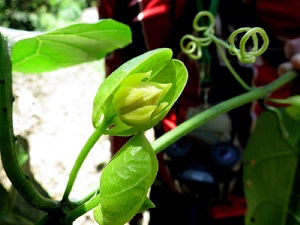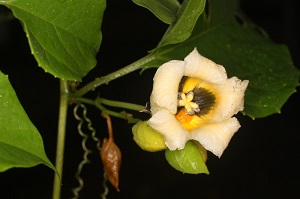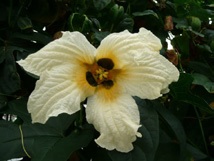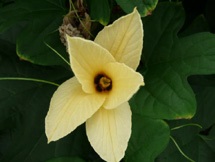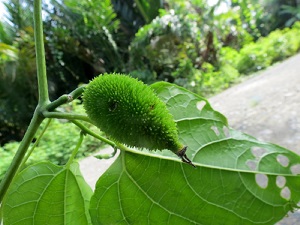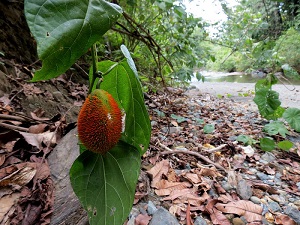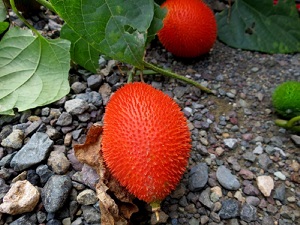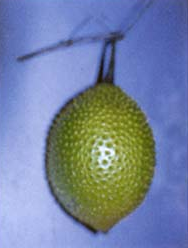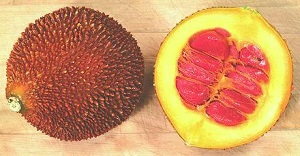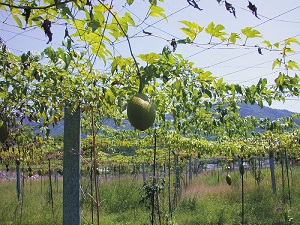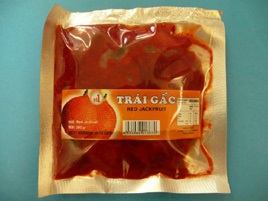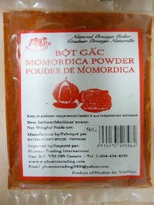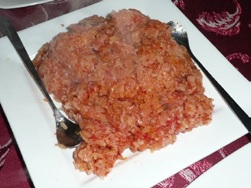| Gac, Chinese cucumber - Momordica cochinchinensis | |||||||||||||||||||||||||||||||||||||||
|---|---|---|---|---|---|---|---|---|---|---|---|---|---|---|---|---|---|---|---|---|---|---|---|---|---|---|---|---|---|---|---|---|---|---|---|---|---|---|---|
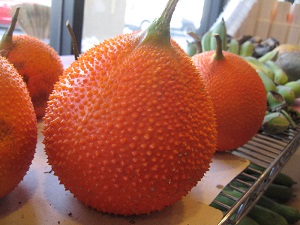 Fig. 1  Momordica cochinchinensis (Quả Gấc) 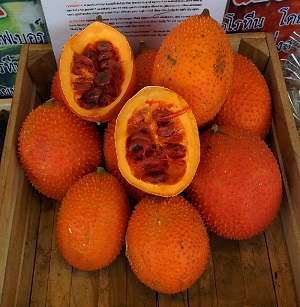 Fig. 2  Gac fruit/spiny bitter gourd/baby jackfruit (M. cochinchinensis) 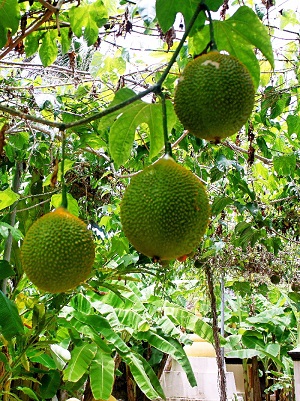 Fig. 3  Tiếng Việt: Quả gấc còn xanh 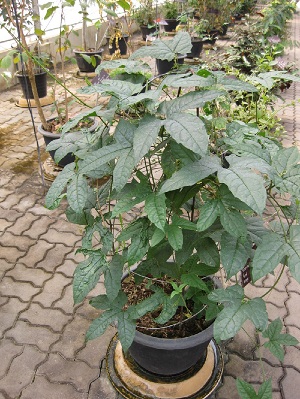 Fig. 4  At the Queen Sirikit Botanic Garden (Chiang Mai Province, Thailand) 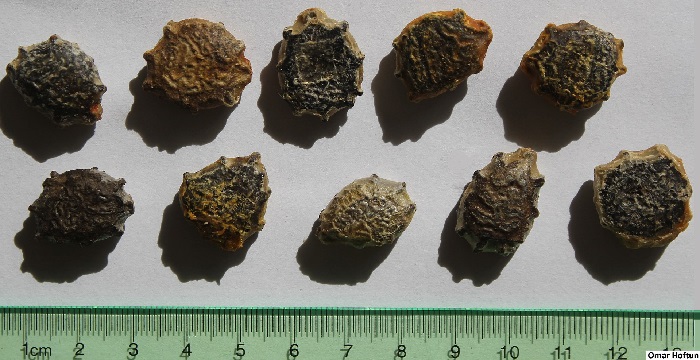 Fig. 15  M. cochinchinensis (Quả Gấc) 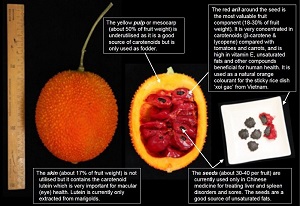 Fig. 19  The components of a gac fruit and their properties 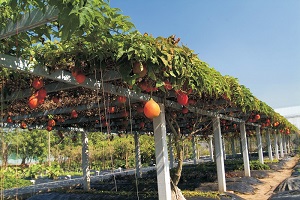 Fig. 22  Field production for ripe fruit 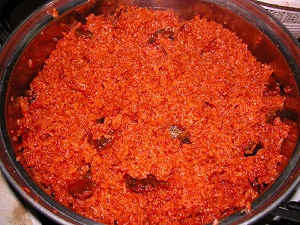 Fig. 23  Glutious rice made with extraction from ripe fruits of M. cochinchinensis, Vietnamese style  Fig. 24  Bundled leaves in the market 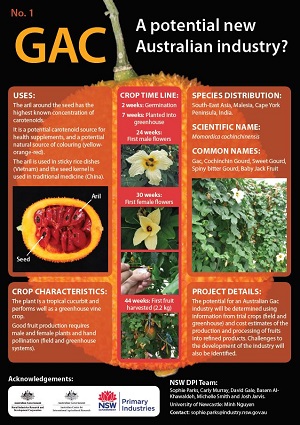 Fig. 30  Poster 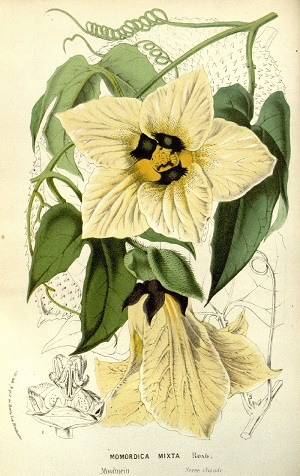 Fig. 31  Louis van Houtte (1810–1876). M. cochinchinensis (Lour.) Spreng. Flore des serres et des jardins de l'Europe. | Scientific
name Momordica cochinchinensis (Lour.) Spreng. Common names English: balsam pear, chinese bitter cucumber, chinese cucumber, gac, giant spine gourd, spiny bitter cucumber, sweet gourd; French: muricie; German: indische bittergurke; Spanish: cundeamor; Swedish: taggig bittergurka; transcribed Chinese: mu bie zi 1 Synonyms M. ovata Cogn.; M. macrophylla Gage; M. meloniflora Hand.-Mazz.; M. mixta Roxb; Muricia cochinchinensis Lour.; Zucca commersoniana Ser. 1,2,3 Relatives Balsam apple, M. balsamina L., bitter melon, M. charantia L. Family Cucurbitaceae Origin Asia-Temperate, Asia-Tropical, Australasia 1 Uses Vegetable; medicine Life Form/physiology Perennial 4; herb; multistem vine from a tuberous root Height/spread Prostrate; procumbent; semi-erect, climber; scrambler; scadent 4 Flower Male and female flowers on separate plants 6 Fruit 4-8 in. x 1.5-2 in. (10-20 cm x 4-5 cm); yellow turning red at maturity 4 Seed Compressed; sculptured; 1x0.08x0.2 in. (2.5x2x0.5 cm); dark brown 5 Light requirement Bright light Photoperiod Short day (<12 hours) 4 Soil texture Medium; well drained 4 pH preference Optimal: 6.5-7; absolute: 6-7.5 4 Cold tolerance Optimal: 68-86 °F (20-30°C); absolute: 57-95 °F (14-35 °C) 4 Seed germination 3 weeks 6 Invasive potential * None known Known hazard Poisonous to mammals 1 Reading Material Momordica - Momordica spp., University of Florida pdf Description The plants grow on trellises with thick, dark green main stems, and laterals that grow to over 3m long. The species is dioecious, having male and female plants, which can only be identified once they are flowering. The species is perennial and grows in tropical and temperate climates where in winter the plant dies back and reshoots from the plant base (tuberous root) in spring. A greenhouse M. cochinchinensis (Gac) crop was grown at the Department of Primary Industries, Gosford Primary Industries Institute, NSW, Australia (151° 19’E, 33° 23’S) from May 2010 to June 2011. The crop took approximately 44 weeks from seed germination to harvest of fruits. 6 Flowers Male flowers have larger petals and are light in colour. Female flowers have a darker yellow flower with 5 simple elliptical petals. The female flower has an inferior ovary. 6 Flowering starts about 2 months after planting and may continue for 6-8 months. 4
Fig. 5. Indonesia, buds Fig. 6. Indonesia, flower Fig. 7. Indonesia, flower. Central Halmahera. Weda Bay. Tanjung Ulie. Prolific herbaceous climber on roadside embankment. Spathe-like bract yellow-green, and calyx dark grey; corolla cream, with large dark grey blotch on three of the petals inside surrounded by yellow-orange area; stamens brown and cream with conspicuous short stout white trichomes. Fig. 13. Male flower Fig. 14. Female flower Fruit Fruit weight appears to be important in determining the proportion of aril obtained from the fruit. The larger, heavier fruits contain proportionally more aril than smaller, lighter fruits. This has great significance since the valuable aril represents only a small part of the fruit and maximising this would be of economic importance. The mesocarp (pulp) of the harvested fruit accounts for between 52 and 75% of the total fruit by weight. 6
Fig. 8. Indonesia, fruit growing Fig. 9. Indonesia, fruit ripening Fig. 10. Indonesia, ripe fruit Fig. 11. Thailand. M. cochinchinensis Spreng, spiny gourd. Thai name: Fak khaao. The fruit of spiny gourd is usually collected from fence climbers or from wild plants. It is found seasonally in local markets. Fig.12. A Quả Gấc Fruit in Vietnam (Saigon) Harvesting Approximately 44 weeks from seed germination to harvest of fruits. 6 Pollination Pollination is chiefly carried out by insects rather than wind and hand pollination results in a higher fruit set than open pollination. 7 Male and female plants are required for production since the species is dioecious. Plant gender cannot be identified from seed and can only be established on flowering. Female flowers need to be hand pollinated to ensure fruits of maximum size. 6 Propagation The plant can be cultivated from seeds or root tubers. Rooted vine cuttings can also be used for propagation and are more reliable than production from seeds, which can be affected by dormancy and a long lead time into production. 7 One problem with seed-grown plants is that more male than female plants are produced. The exact ratio of male to female plants produced from the seeds of one fruit has not been identified. Taking cuttings from female plants or using the unwanted male plants as rootstock with female scions are two ways to boost the number of female plants. The ratio of 1 male to 10 female plants has been suggested as adequate to supply enough pollen for good fruit set. 6
Fig. 17. Exterior and cross-sectional interior of gac Fig. 18. Typical composition of fresh Gac fruit: skin: 18%, yellow pulp: 49%, aril: 18%, seeds: 14% Planting Gac is a climbing vine crop so it needs to be trellised and trained to allow it to fully develop and produce fruit. Trellising also prevents fruit from growing on the ground and rotting since it is soft when ripe. 6
Fig. 20. The trellis used for gac in the greenhouse study. Bags were 1 metre apart and horizontal wires were at 1m, 1.8 m and 2.8 m above the ground. Fig. 21. Field production for young fruit Food Uses As a fresh product, the uses for gac are predominantly in Asian cuisine, particularly Vietnamese. Although gac is usually cooked, it does not require cooking for consumption. 6 Immature fruits, young leaves and flowers are used as vegetables. 4 To remove most of the bitterness the fruit is soaked in salt water and boiled or parboiled. Young leaves and flowers are eaten boiled or stir-fried; young fruit is boiled or used in soup after peeling rind; mature fruit cooked along with seeds to flavor and add red color to rice dishes for festive occasions. 5 The red aril around the seed is the most valuable fruit component (18-30% of fruit weight). It is very concentrated in carotenoids (β-carotene and lycopene) compared with tomatoes and carrots, and is high in vitamin E, unsaturated fats and other compounds beneficial for human health. 6 Its natural orange colouring and mild flavour also lends itself to be used as a natural colouring in cooking, much like the way saffron and turmeric is used. 6
Fig. 25. Example of a frozen aril product. Red jackfruit is another name given to gac Fig. 26. Example of gac cooking powder Fig. 27,28. Examples of juices on the market containing gac aril Fig. 29. The traditional Vietnamese dish xoi gac made with sticky rice and aril Recipe for xoi gac, Rural Industries Research and Development Corporation Other Uses The seeds contain an oil that is used as an illuminant. Its roots froth in water and can be used as soap. 4 The seeds (about 30-40 per fruit) are currently only used in Chinese medicine for treating liver and spleen disorders and sores. The seeds are a good source of unsaturated fats. (Fig. 19). The yellow pulp or mesocarp (about 50% of the fruit weight) is underutilised as it is a good source of carotenoids but is only used as fodder. 6 Other Edibles in the Momordica genus: Balsam apple, M. balsamina Bitter Melon, M. charantia Further Reading Momordica cochinchinensis, Discovering Indigenous Treasures Assessing the Potential for a Gac (Cochinchin gourd) Industry in Australia, Rural Industries Research and Development Corporation pdf Propagation And Production Of Gac (Momordica cochinchinensis Spreng.), A Greenhouse case Study, Central Coast Primary Industries Centre, Australia pdf Bitter Gourd: Botany, Horticulture, Breeding, Horticultural Reviews pdf Effects of maturity on physicochemical properties of Gac fruit (Momordica cochinchinensis Spreng.), University of Newcastle, Australia pdf List of Growers and Vendors | ||||||||||||||||||||||||||||||||||||||
| Bibliography 1 "Taxon: Momordica cochinchinensis (Lour.) Spreng." No. 24521. U.S. National Plant Germplasm System, www.ars-grin.gov/npgs/. Accessed 9 Jan. 2018. 2 "Momordica cochinchinensis (Lour.) Spreng." Missouri Botanical Garden, www.tropicos.org/Name/9201691. Accessed 6 Jan.2017. 3 "Momordica cochinchinensis (Lour.) Spreng synonyms." The Plant List (2013). Version 1.1., www.theplantlist.org/tpl1.1/record/kew-2372841. Accessed 9 Jan. 2018. 4 “Momordica charantia L.” Ecocrop, Food and Agriculture Organization of the United Nations, 2014, ecocrop.fao.org/ecocrop/srv/en/cropView?id=7797. Accessed 16 Jan. 2018. 5 Lin, L. J., et al. "Momordica cochinchinensis." Discovering Indigenous Treasures: Promising Indigenous Vegetables From Around The World, publication No. 09-720, AVRDC – The World Vegetable Center, Shanhua, Taiwan, 2009, 4 July 2012, pp. 164-167, (CC BY-NC-SA 3.0), avrdc.org/wpfb-file/ebook1-htm/. Accessed 8 Jan. 2018. 6 Parks, Sophie. "Assessing the Potential for a Gac (Cochinchin gourd) Industry in Australia." Publication No. 13/060, July 2013, Rural Industries Research and Development Corporation. www.agrifutures.com.au/publications/assessing-the-potential-for-a-gac-cochinchin-gourd-industry-in-australia/. Accessed 10 Jan 2018. 7 Parks, Sophie. "Propagation and cultivation of Gac plant." Gac Research, University of Newcastle, Australia. gacfruit.weebly.com/propagation-and-cultivation-of-gac-plant.html. Accessed 16 Jan 2018. Photographs Fig. 1 Quang, Nguyễn Thanh. Momordica cochinchinensis (Quả Gấc). 14 Dec. 2007, (CC BY 2.0), commons.wikimedia.org/wiki/File:Qu%E1%BA%A3_G%E1%BA%A5c.jpg. Accessed 13 Jan. 2018. Fig. 2 Slater, Susan. Gac fruit/spiny bitter gourd/baby jackfruit (Momordica cochinchinensis). 19 Dec. 2015, (CC BY-SA 4.0), commons.wikimedia.org/wiki/File:72_-_gac.jpg. Accessed 13 Jan. 2018. Fig. 3 Bùi Thụy Đào Nguyên. Tiếng Việt: Quả gấc còn xanh. 9 May 2014 (CC BY-SA 3.0). commons.wikimedia.org/wiki/File:Quả_gấc_VN.jpg. Accessed 15 Jan. 2018. Fig. 4 Kojian, Raffi. Momordica cochinchinensis (Lour.) Spreng. Photographed at the Queen Sirikit Botanic Garden (Chiang Mai Province, Thailand) in March. 9 Mar. 2011, (CC BY-SA 3.0), gardenology.org/wiki/Main_Page, commons.wikimedia.org/wiki/File:Gardenology.org-IMG_8003_qsbg11mar.jpg. Accessed 13 Jan. 2018. Fig. 5 Bangun, Tjut Jul Fatisa. M. cochinchinensis (Lour.) Spreng., 20 Oct. 2012, Weda Bay Project, Missouri Botanical Garden, (CC BY-NC-ND 3.0), tropicos.org/Image/100238958. Accessed 29 Dec. 2017. Fig. 6 Bangun, Tjut Jul Fatisa. M. cochinchinensis (Lour.) Spreng., 20 Oct. 2012, Weda Bay Project, Missouri Botanical Garden, (CC BY-NC-ND 3.0), tropicos.org/Image/100238955. Accessed 29 Dec. 2017. Fig. 7 Phillipson Peter B. M. cochinchinensis (Lour.) Spreng., 9 Sep. 2013, Weda Bay Project, Missouri Botanical Garden, (CC BY-NC-ND 3.0), tropicos.org/Image/100314755. Accessed 29 Dec. 2017. Fig. 8 Bangun, Tjut Jul Fatisa. M. cochinchinensis (Lour.) Spreng., 21 Oct. 2012, Weda Bay Project, Missouri Botanical Garden, (CC BY-NC-ND 3.0), tropicos.org/Image/100238992. Accessed 29Dec. 2017. Fig. 9 Haris, Idris Abdul. M. cochinchinensis (Lour.) Spreng., 22 Oct. 2012, Weda Bay Project, Missouri Botanical Garden, (CC BY-NC-ND 3.0), tropicos.org/Image/100237987. Accessed 29Dec. 2017. Fig. 10 Bangun, Tjut Jul Fatisa. M. cochinchinensis (Lour.) Spreng., 21 Oct. 2012, Weda Bay Project, Missouri Botanical Garden, (CC BY-NC-ND 3.0), tropicos.orgg/Image/100238987. Accessed 29Dec. 2017. Fig. 11 Spiny gourd: seasonally marketed. (Momordica cochinchinensis Spreng.), 1999, The Vegetable Sector in Thailand, Food and Agriculture Organization of the United Nations, www.fao.org/docrep/004/ac145e/AC145E09.htm. Accessed 1 July 2017. Fig. 12 Schwaiger, Mario J. A Quả Gấc Fruit in Vietnam (Saigon). 16 Dec. 2012, (CC-BY-SA-3.0), commons.wikipedia.org/wiki/File:Qua_Gac.JPG. Accessed 9 Jan. 2018. Fig. 13 Male Flower. Publication No. 13/060, July 2013, Rural Industries Research and Development Corporation, www.agrifutures.com.au/publications/assessing-the-potential-for-a-gac-cochinchin-gourd-industry-in-australia/. Accessed 10 Jan 2018. Fig. 14 Female Flower. Publication No. 13/060, July 2013, Rural Industries Research and Development Corporation, www.agrifutures.com.au/publications/assessing-the-potential-for-a-gac-cochinchin-gourd-industry-in-australia/. Accessed 10 Jan 2018. Fig. 15 Hoftun, Omar. Momordica cochinchinensis (gac fruit) seeds. 29 May 2017, (CC BY-SA 4.0), commons.wikimedia.org/wiki/File:Momordica_cochinchinensis_seeds,_by_Omar_Hoftun.jpg. Accessed 13 Jan. 2018. Fig. 17 Grygus, Andrew. Exterior and cross-sectional interior of gac. 4 Sep. 2009, (CC BY 3.0), clovegarden.com/ingred/gd_gacz.html, commons.wikimedia.org/w/index.php?curid=18172031. Accessed 13 Jan.2018. Fig. 18 Typical composition of fresh Gac fruit: Skin: 18%, Yellow pulp: 49%, Aril: 18%, Seeds: 14%. Gac Research, School of Environmental and Life Sciences, University of Newcastle, Australia, gacfruit.weebly.com/research-activity.html. Accessed 16 Jan. 2018. Fig. 19 The components of a gac fruit and their properties. July 2013, Assessing the Potential for a Gac (Cochinchin gourd) Industry in Australia. Publication No. 13/060, Rural Industries Research and Development Corporation, www.agrifutures.com.au/publications/assessing-the-potential-for-a-gac-cochinchin-gourd-industry-in-australia/. Accessed 10 Jan 2018. Fig. 20 The trellis used for gac in the greenhouse study. Bags were 1 metre apart and horizontal wires were at 1m, 1.8 m and 2.8 m above the ground. July 2013, Publication No. 13/060, Rural Industries Research and Development Corporation, www.agrifutures.com.au/publications/assessing-the-potential-for-a-gac-cochinchin-gourd-industry-in-australia/. Accessed 10 Jan 2018. Fig. 21 Lin, L. J., et al. Field production for young fruit. 4 July 2012, Discovering Indigenous Treasures: Promising Indigenous Vegetables From Around The World, publication No. 09-720, AVRDC – The World Vegetable Center, Shanhua, Taiwan, 2009, pp. 164-167, (CC BY-NC-SA 3.0), avrdc.org/wpfb-file/ebook1-htm/. Accessed 8 Jan. 2018. Fig. 22 Lin, L. J., et al. Field production for ripe fruit. 4 July 2012, Discovering Indigenous Treasures: Promising Indigenous Vegetables From Around The World, publication No. 09-720, AVRDC – The World Vegetable Center, Shanhua, Taiwan, 2009, pp. 164-167, (CC BY-NC-SA 3.0), avrdc.org/wpfb-file/ebook1-htm/. Accessed 8 Jan. 2018. Fig. 23 Nguyễn Thanh Quang. Glutious rice made with extraction from ripe fruits of Momordica cochinchinensis, Vietnamese style. 3 Nov. 2007, Public domain, commons.wikipedia.org/wiki/Category:Momordica_cochinchinensis#/media/File:Xôi_gấc.JPG. Accessed 9 Jan. 2018. Fig. 24 Bundled leaves in the market. Momordica cochinchinensis. 4 July 2012, Discovering Indigenous Treasures: Promising Indigenous Vegetables From Around The World, publication No. 09-720, AVRDC – The World Vegetable Center, Shanhua, Taiwan. 2009, 4 July 2012, (CC BY-NC-SA 3.0), avrdc.org/wpfb-file/ebook1-htm/. Accessed 8 Jan. 2018. Fig. 25 Example of a frozen aril product. Red jackfruit is another name given to gac. July 2013, Publication No. 13/060, Rural Industries Research and Development Corporation, www.agrifutures.com.au/publications/assessing-the-potential-for-a-gac-cochinchin-gourd-industry-in-australia/. Accessed 10 Jan. 2018. Fig. 26 Example of gac cooking powder. July 2013, Publication No. 13/060, Rural Industries Research and Development Corporation, www.agrifutures.com.au/publications/assessing-the-potential-for-a-gac-cochinchin-gourd-industry-in-australia/. Accessed 10 Jan. 2018. Fig. 27,28 Example of juices on the market containing gac aril. July 2013, Publication No. 13/060, Rural Industries Research and Development Corporation, www.agrifutures.com.au/publications/assessing-the-potential-for-a-gac-cochinchin-gourd-industry-in-australia/. Accessed 10 Jan. 2018. Fig. 29 The traditional Vietnamese dish xoi gac made with sticky rice and aril. July 2013, Publication No. 13/060, Rural Industries Research and Development Corporation, www.agrifutures.com.au/publications/assessing-the-potential-for-a-gac-cochinchin-gourd-industry-in-australia/. Accessed 10 Jan. 2018. Fig. 30 Gac. A Potential New Australian Industry? Gac Research. School of Environmental and Life Sciences, University of Newcastle, Australia, gacfruit.weebly.com/uploads/2/1/4/5/21454370/gac_poster_print_-_sophie.pdf. Accessed 10 Jan. 2018. Fig. 31 Houtte, Louis van. Momordica cochinchinensis (Lour.) Spreng. Flore des serres et des jardins de l'Europe, 1861, ou descriptions et figures des plantes les plus rares et les plus méritantes, nouvellement introduites sur le continent ou en Angleterre ... XIV. Public domain, commons.wikimedia.org/wiki/File:Flore_des_serres_v14_227a.jpg. Accessed 16 Jan. 2018. * UF/IFAS Assessment of Non-native Plants in Florida's Natural Areas ** The information provided above is not intended to be used as a guide for treatment of medical conditions using plants. Published 28 Jan. 2018 KJ. Last update 20 Jan. 2020 KJ | |||||||||||||||||||||||||||||||||||||||
